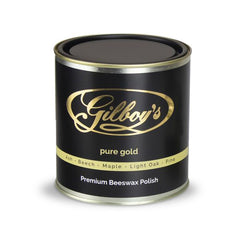How Our Beeswax Wood Polish Is Made
Simon GilboyShare
The Complete Story of Our Beeswax Polish
Beeswax is known to have been in use on wooden artefacts as early as the time of the ancient Egyptian craftsmen and its use in the fine arts can be traced back over 2,000 years. - Concise encyclopedia of chemical technology (Kirk Othmer, 1985)
Honeybees (genus: Apis) are the only bees to produce wax and use it to build structures to store honey and protect their young. They have been around for over 30 million years. Only the worker bees produce wax and then only for approximately 5 days of their short lives. All worker bees are infertile females.
Life Cycle of Worker Honeybees
Days 1-2: Cell cleaning
When a worker bee is born, she becomes a house bee, a worker within the hive, first cleaning her own birth cell, then cleaning other cells, preparing them for new eggs to be laid. Brood cells will be inspected by the queen and if she finds them unsatisfactory she will not use them. Worker bees in the cleaning phase will perform this cleaning again and again until the queen is satisfied.
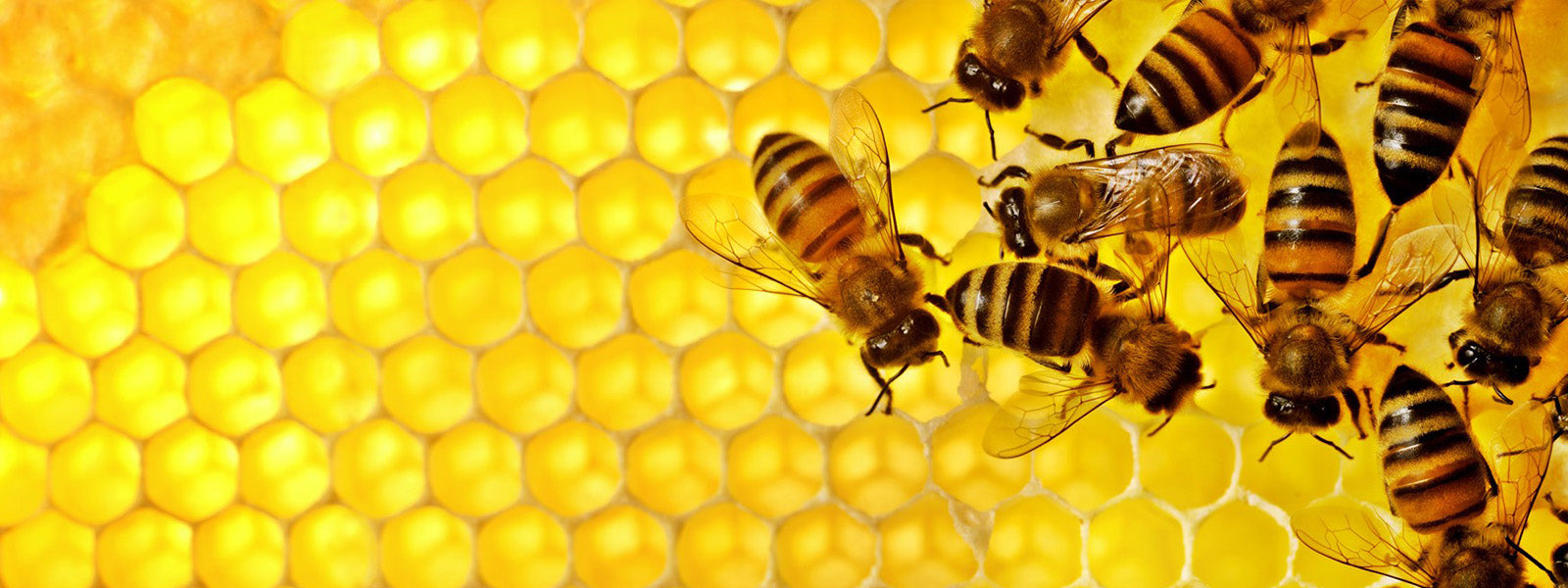
Days 3-11: Nursing
For bees, pollen is the primary source of the ten amino acids they need to build protein. Most of the pollen is eaten by worker bees in their nursing phase. The nurses use the nutrition absorbed from the pollen to feed all the young larvae, including workers, drones and queens using royal jelly secreted from their hypopharyngeal glands in their mouthparts. Royal jelly is 67% water, 12.5% protein, 11% simple sugars (monosaccharides), 6% fatty acids and 3.5% 10-hydroxy-2-decenoic acid (10-HDA) - the 'magic' ingredient. Nurse bees work around the clock without sleep for 9 days!
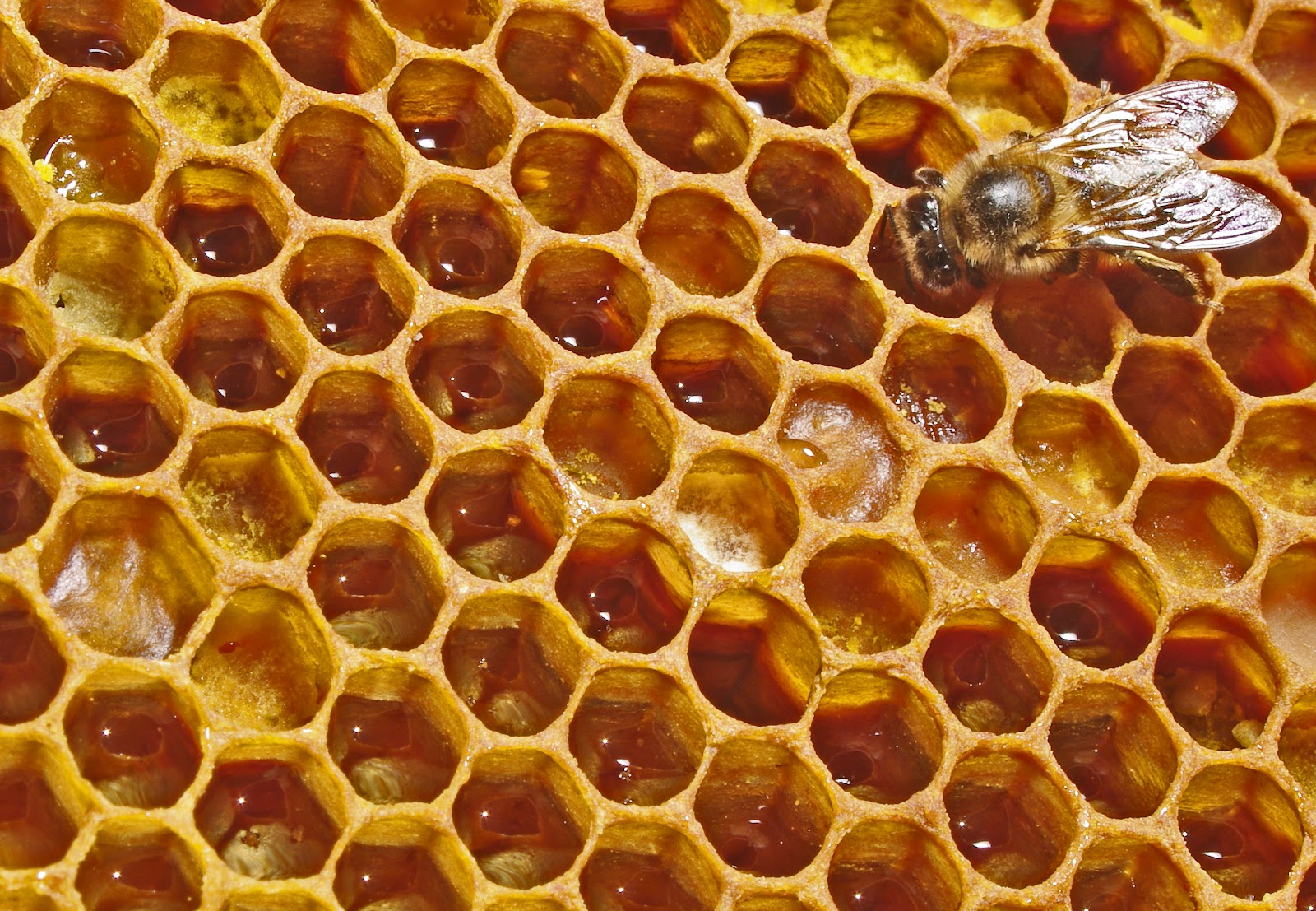
Days 7-11: Attending the Queen
During this phase the bees spend their time feeding and grooming the queen. Even more important is their incidental role in spreading Queen Mandibular Pheromone (QMP) throughout the hive. This is a pheromone given off by queen which is a signal to the rest of the bees that the hive still has a viable queen.
Days 12-17: Wax production
For just five days worker bees will exude wax from four sets of wax glands on to 'mirrors', situated inside the last four ventral segments of the abdomen. They discard the 1mg wax scales which are in turn collected by other worker bees and used in the construction of the comb.
"At least twenty pounds of honey are consumed in making a single pound of wax"
- The Hive & The Honey Bee, A beekeepers manual by Rev L.L. Langsroth (1853)
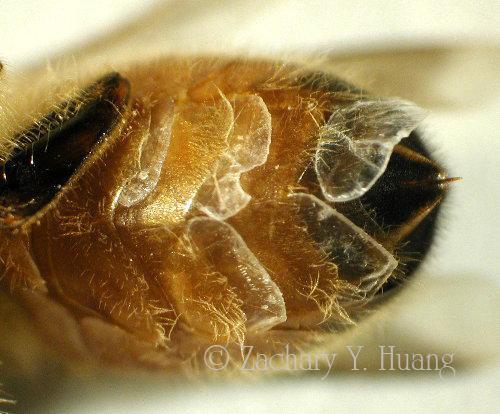
Days 17-22: Career
During this period there are many worker bee roles that can be assumed:
- Honey sealing: Where a wax cap is applied to honey stores that have dried sufficiently, to prevent absorption of water from the air.
- Drone feeding: Drone bees need to be fed by workers when they are young until they learn to feed themselves from the honey supply.
- Honeycomb building: Workers will collect discarded wax scales or take them directly from wax producing workers and build the comb with it.
- Pollen packing: Pollen that is brought into the hive for feeding the brood is packed into honeycomb cells and mixed with a small amount of honey to prevent it from spoiling. Stored pollen will become rancid unless protected by the antibacterial properties of honey.
- Propolising: The worker bees cover the walls of the hive with a thin coating of propolis (a resinous substance obtained from plants). When combined with enzymes added by the bees, propolis has been shown to have very strong antibacterial and antifungal properties.
- Mortuary duties: Mortuary workers carry and drop dead bees and failed larvae some distance from the hive.
- Fanning: These worker bees fan the hive, directing airflow into the hive or out of the hive depending on need. They are able to cool it with evaporated water brought by forager bees who obtain water, usually from within a short distance from the hive and bring it back to spread on the backs of the fanning bees. The worker bee has a crop separate from the nectar crop specifically for this purpose.
- Guard duty: Guard bees will stand at the front of the hive entrance, defending it from any invaders such as wasps.
Days 22-42: Foraging and Scouting
These are the bees you see busily buzzing about collecting nectar, pollen, water and propolis to bring back to the hive. Field bees work themselves to death, foraging until, one day, they do not return from their foray.
What is Beeswax Exactly?
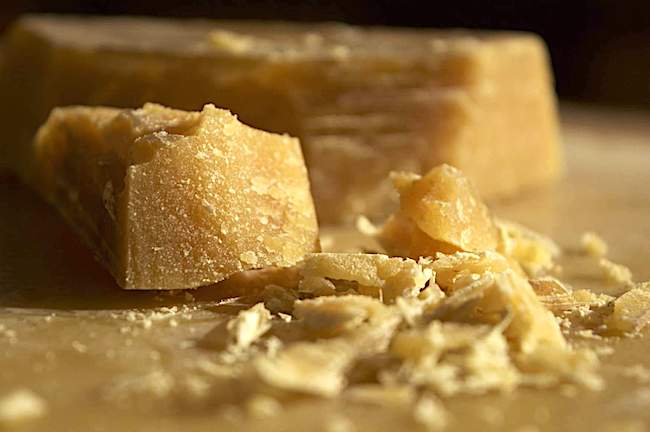
As mentioned above, when a worker bee is 12 days old they begin to excrete a very special wax onto 'mirrors' from four sets of wax glands on the underside of their abdomen. This process lasts for just five days.
Chemically, beeswax consists mainly of esters of fatty acids (an organic compound made by replacing the hydrogen of an acid by an alkyl or other organic group. Many naturally occurring fats and essential oils are esters of fatty acids) and various long-chain alcohols. An approximate chemical formula for beeswax is C15H31COOC30H61. Beeswax comprises of about 64% wax esters, 14% hydrocarbons and 12% free fatty acids, a composition that is genetically determined for each species and varies to only a small extent. Wax esters are formed by combining one fatty acid with one fatty alcohol. Many naturally occurring fats and essential oils are esters of fatty acids.
The main components of beeswax are:
- Palmitate
- the most common saturated fatty acid found in animals, plants and microorganisms. It is a major component of the oil from the fruit of oil palms (palm oil)
- Palmitoleate
- biosynthesized from palmitic acid by the action of the enzyme Stearoyl-CoA desaturase-1
- Oleate esters of long-chain aliphatic alcohols
- an organic compound made by replacing the hydrogen of an acid by an alkyl or other organic group), with the ratio of triacontanyl palmitate to cerotic acid, the two principal components, being 6:1
Beeswax properties
How have humans made use of beeswax?
The earliest record of humans eating honey can be dated to roughly 3 million years ago, with extensive exploitation of honey bees dating around 10,000 years ago. Early civilisations discovered the useful properties of honey and beeswax and have utilised them in innumerable ways over the centuries. 4,500 year old beeswax has been discovered in Egyptian tombs, on Viking longboats and Roman remains and still retaining many of its properties. Traces of beeswax have been found in pot shards throughout the Middle East beginning about 7,000 BCE (Widespread exploitation of the honeybee by early Neolithic farmers)
In ancient Greece, aspects of the lives of bees and beekeeping are discussed at length by Aristotle. Beekeeping was also documented by the Roman writers Virgil, Gaius Julius Hyginus, Varro, and Columella. Honey-deprived British colonists took honeybees with them all over the Victorian empire. Today the western honey bee can be found on every continent except Antarctica.
Long before paraffin and gas lamps or electric light bulbs, the wax candle was humankind's primary source of light in the darkness. Beeswax makes the best candles because they produce a bright flame, do not smoke or sputter and produce a fragrant odor while being burned. In medieval times the demand for beeswax was extremely high, not least because the Catholic church ordained that every Catholic home should have two blessed candles in addition to a crucifix and that the candles should be made from beeswax.
Needless to say an awful lot of beeswax candles would be used in churches and monasteries; and so it follows that many monasteries maintained their own apiaries and the monks became experts at beekeeping.
We source our beeswax from our local Abbey here in Buckfastleigh; Buckfast Abbey. We're very lucky to have access to some of the very best beeswax thanks to the work of a legendary monk called Brother Adam.
Brother Adam
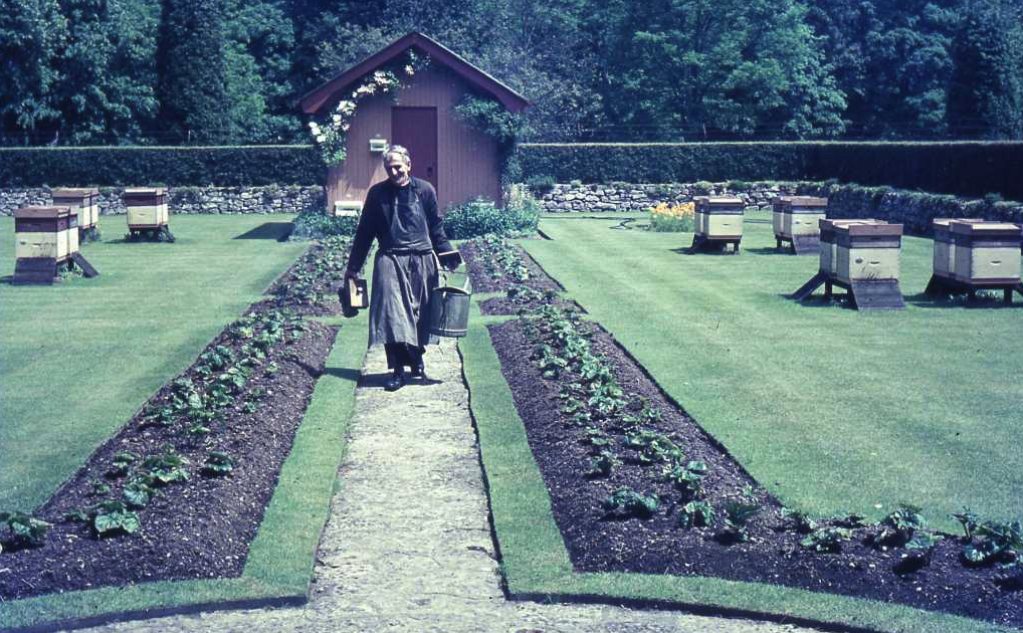
Brother Adam (Karl Kehrle) was sent to the Benedictine Monks at Buckfast Abbey by his mother at the age of 11 in 1909. In 1915, aged 17 be began his beekeeping activity, going on to become a highly respected authority on bee breeding and renowned developer of the now-famous Buckfast Bee. Just one year after he started looking after the bees, 30 of the 46 colonies were wiped out by the 'Isle of Wight Disease' that was sweeping across the UK. An infestation of mites (Acarapis woodi) that live and reproduce in the tracheae of the bees. All the native English black bees were wiped out and only two species survived. These were either pure Ligurian (Italian) or of Ligurian origin, hybrids between Ligurian and the English black bee. Brother Adam set about rebuilding the apiary and was intrigued at how the surviving colonies were resistant to the mites. He imported some more Italian queens and began a breeding programme. In 1917 he created the first Buckfast strain, a very productive bee resistant to the parasite.
After the retirement of Brother Columban 1919, Brother Adam was put in charge of the abbey's apiary. For the next 78 years he continued his gradual improvement of the Buckfast bee by analysing and crossing bees from places all over Europe, the Near East and North Africa. He investigated various various honey bee races and made many long journeys to Europe, Africa and the Middle East searching for new races and interesting local stocks. The book In Search of the Best Strains of Bee tells about his travels in search of genetic building blocks. Today the Buckfast bee is very popular among beekeepers worldwide. Most of the Buckfast bee's qualities are very favourable. They are extremely gentle and highly productive.
In 1964 Brother Adam was elected member of the Board of the Bee Research Association, which later became the International Bee Research Association. He continued his studies of the Buckfast bee and his travels during the 1970s and received several awards, including an OBE in 1973 and the German Federal Cross of Merit in 1974.
On 2 October 1987 he was appointed Honorary doctor by the Swedish University of Agricultural Sciences while in search of a bee on the Kilimanjaro mountains in Tanzania and Kenya, which deeply moved him and he saw as the official recognition of the scientific nature of his research. Two years later he was appointed Honorary doctor by Exeter University.
On 2 February 1992, aged 93, he resigned his post as beekeeper at the Abbey and spent some months in his home town Mittelbiberach with his niece, Maria Kehrle. From 1993 onwards, he lived a retired life back at Buckfast Abbey, and became the oldest monk of the English Benedictine Congregation. In 1995, at age 97, he moved to a nearby nursing home where he died on 1 September 1996.
The Buckfast apiaries continue to thrive today. Although a new direction has now been adopted that befits the environmentally-aware generation of the 21st century. It is that of gentle bee-keeping, with the emphasis shifting from commerce to community with just 40 hives today kept for research and education instead of 400.
We have a great relationship with the beekeeping staff at Buckfast Abbey and feel honoured to have such blessed beeswax exclusively provided for use in our polishes.
Why is beeswax used in furniture polish?
For centuries beeswax has been known to have the protective qualities of extraordinary degradation resistance, impermeability to air, moisture, pests and fungi. What is not so clear is when exactly we started using it to protect wood finishes. Certainly since biblical times, and probably before, people have recognised the usefulness of coating wooden surfaces with oils, balms and unguents to stop them drying out. In twelfth-century Italy, plant oils were commonly used to polish wooden floors. By the fourteenth century, beeswax was being used to treat inlaid wood and parquetry floors in France. Beeswax became a very popular wood polish but had to be applied with hot irons as there was no known solvent to soften the wax. We know that Stradivari used Venetian Turpentine in the lacquer finishes of his violins between 1690 and 1725.
Before 1650, fine furniture was a rarity in Western Europe and North America. Generally, people made do with simple but serviceable pieces. The latter half of the 18th century saw the rise of master cabinet makers such as Thomas Sheraton, Thomas Chippendale and George Hepplewhite. These ornate pieces of furniture were finished with fine lacquers that would be expensive to repair or replace, so a protective and sacrificial layer of beeswax polish would be applied that could be replaced easily and as often as required.
What's so special about Gilboy's Gold Beeswax Furniture Polish?
As antique furniture restorers that use traditional techniques, we were keen to use a beeswax polish made using a traditional recipe. Unfortunately we found that every brand we tried had succumbed to cost reduction and profit margin pressures and changed the formula to include cheaper solvents such as white spirit or a reduction the volume of beeswax. So we set about formulating our own beeswax polish starting with a traditional recipe and using the very best ingredients we could find. This included pure pine turpentine and locally sourced beeswax from Buckfast Abbey.
Since then we have invested a great deal of time and resources in research and development to improve our wax polish without compromising on quality or performance. We are not interested in competing on price, our only interest (as furniture restorers) is making the very best beeswax polish. To this end, we don't use any cheap-alternative petrochemical solvents such as white spirit or toluene. Only pure pine turpentine is used to soften the waxes in the traditional manner. And we certainly do not use any silicones - in fact we don't even allow any silicones to enter our workshops!
Today Gilboy's Gold contains just enough T1 grade carnauba wax (the hardest of all natural waxes) to provide and more hard-wearing finish with a deeper shine without it being so hard as to be difficult to refresh or replace or impact the resonant properties of stringed instruments.




